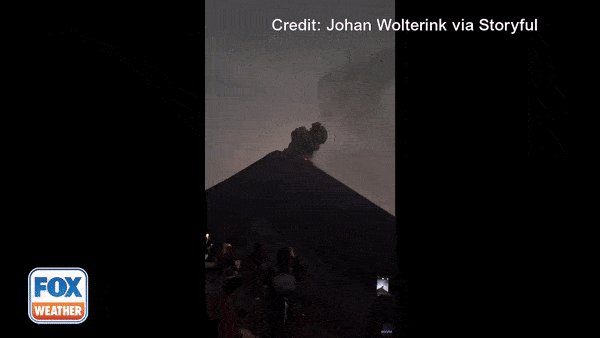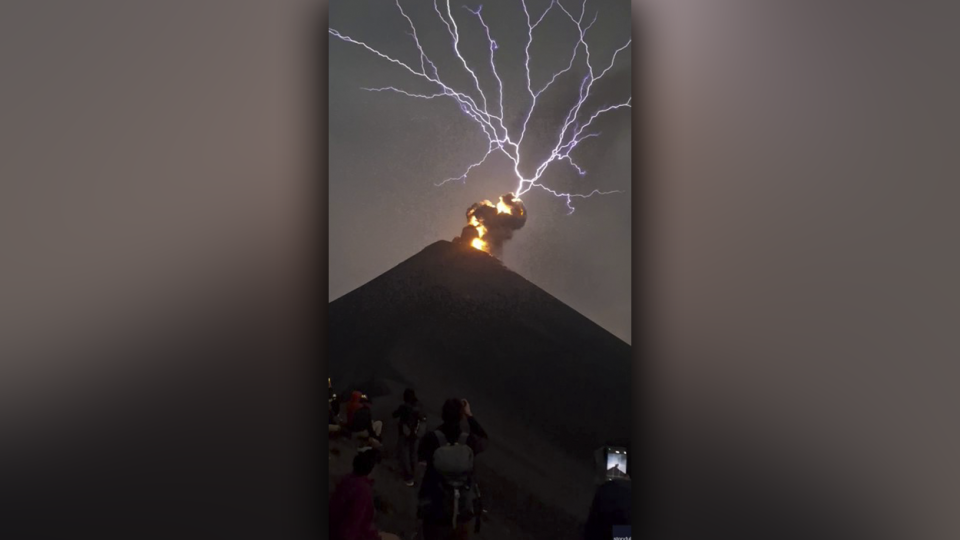Watch: Brilliant lightning appears to hit erupting volcano in Guatemala
ANTIGUA, Guatemala – Crowds that flocked to watch the Volcano of Fire erupt last month were treated to a crazy light show when lightning apparently struck the mountain top.
Listen to the crowd that was already buzzing with excitement watching one of the most active volcanoes in Central America erupt with ash and glowing lava. A storm overhead set off lightning flashes every now and then.
The ash plume was expanding, and you can hear the cameras clicking rapidly. Then a bolt appears to reach from a cloud, creates a spiderweb of branching bolts then explodes and lights the night sky. Thunder echos across the landscape accompanied by the wonderment of the crowd.
"What are the odds?" posted the photographer on social media.
Well, the odds are actually better than he thought. The different sizes of ash accelerating through the cloud rub against each other and produce static electricity. It is like rubbing a balloon on your sweater to generate a shock. So, volcanoes can actually produce their own lightning.
‘VOLCANO OF FIRE’ ERUPTS IN CENTRAL AMERICA

"Similarly (to a thunderstorm), in a volcanic eruption cloud, there are small particles of volcanic material colliding with one another at high speeds, and these collisions can result in separation of charges in the volcanic cloud that result in lightning," said scientists at the University of Hawaii's Center for the Study of Active Volcanoes.
FOX Weather Senior Producer and Meteorologist Greg Diamond went through the video frame by frame.
"Based on this image, I believe the lightning originated from the ash cloud first," Diamond said.
CAN VOLCANIC ERUPTIONS AFFECT THE WEATHER?

The erupting volcano sent ash, particles and heated gas almost 1,000 feet high and more than 18 miles away, according to the National Institute of Seismology, Volcanology, Meteorology and Hydrology of Guatemala. A 2013 study found that electrically charged ash particles travel hundreds of miles from the vent.
"When the opposite charges build up enough, the insulating capacity of the air breaks down and there is a rapid discharge of electricity that we know as lightning," wrote NOAA's National Severe Storms Lab. "(The actual breakdown process is still poorly understood.) The air breakdown creates ions and free electrons that travel down the conducting channel."
The conducting channel is an inch or 2 in diameter, according to NOAA. For ash plumes and most thunderstorm clouds, the actual lightning flash is a combination of negatively-charged stepped leaders. Each reaches out in rapid succession about 150 feet, looking for a positive surface.
About 450 feet from the positive area, the leader connects with a developing positive charge, sometimes called an upward streamer. When the two finally connect, the results are explosive. That creates the conductive path for the rapid discharge of electricity and flash.
"They essentially acted as stepped leaders and when they connected with the positive charges within the storm cloud, it led to the massive return stroke," said Diamond.
The human eye can't make out the fast stepped leaders that travel around 200,000 mph.
"The highly visible return stroke moves upward through the leader channel at about 200 million miles per hour," stated the NWS. "The combination of the stepped leader and return stroke happens in just a fraction of a second."
We just see the discharge – a bolt that appears to flicker.
Scientists studied the Fire Volcano during a 2018 eruption and found that the eruption started around 2 p.m. Ash was emitted before 5 p.m. and the first volcanic lightning strike was at 6:14 p.m. The lightning continued through 10 p.m. The researchers counted 75 unique flashes.
The June 3, 2018, eruption killed 165 people and 260 more are still missing, according to Guatemalan authorities.
Original article source: Watch: Brilliant lightning appears to hit erupting volcano in Guatemala

